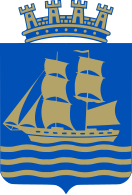Grimstad
| coat of arms | map | |
|---|---|---|

|
|
|
| Basic data | ||
| Commune number : | 4202 | |
| Province (county) : | Agder | |
| Administrative headquarters: | Grimstad | |
| Coordinates : | 58 ° 20 ' N , 8 ° 36' E | |
| Surface: | 303.59 km² | |
| Residents: | 23,544 (Feb 27, 2020) | |
| Population density : | 78 inhabitants per km² | |
| Language form : | Bokmål | |
| Website: | ||
| politics | ||
| Mayor : | Beate Skretting ( H ) (2019) | |
| Location in the province of Agder | ||

|
||
Grimstad is a municipality and coastal city (12,172 inhabitants in 2014) in southwest Norway . It lies in the province ( Fylke ) Agder . Your neighboring communities are Arendal in the east, Froland and Birkenes in the north and Lillesand in the south.
etymology
Grim is a synonym for the pagan god Odin. See also Grimsby (Grims place), Grim's Dyke (for the Antoninus Wall), Grim's Ditch an earthwork , Grims lake (Grims lake), Grimsbury Castle Hillfort in Oxfordshire , Grimsthorpe (Grim's village), Grimspound in Cornwall, Grimsay in the Hebrides too Graemsay as Orkney Island , Grímsey as an island off Iceland, Grimsøy in Norway (Grims Island), Grimsbu in Norway (Grims Hut), Grimsvik (Grims Bay) and several places called Grimston.
geography
The city and the surrounding area extend over an area of 950 million year old reddish granite deposits, which are also known as Fjære granite or Grimstadt granite. For the monumental buildings planned by Albert Speer in Berlin on behalf of Adolf Hitler, rough blocks of this granite were broken in a quarry in Fjære since 1940, some of which were still stored there until the end of the 1970s. They were also known as Hitler stones in Norway . In the disused quarry there has been an open-air theater since 1993, the Agder Theater Fjæreheia. Grimstad is surrounded by 5 mountains: Binabben, Kirkeheia, Knibeheia, Møllerheia and Vardeheia. The highest point of the municipality is the Dobbelshei (361 moh). In front of the city is a large number of islands that form an archipelago park and are popular destinations especially for boaters in summer. The most famous are the island of Hesnesøy, the Hesnes Canal and the Redda Canal. The sun shines here more often than anywhere else in Norway.
history
Prehistoric traces can be found in the Ytre Grevstad site .
In what is now the center of Grimstad, numerous testimonies from the time of the Great Migration and the Vikings have been found. Grimstad originated as a fishing village in the Middle Ages and was first mentioned on Dutch maps in 1528. Grimstad was granted town charter in 1816. On January 1, 1971, the municipalities of Fjære and Landvik were merged with Grimstad. In 1907 Grimstad received a railway connection. The Grimstad Railway , which ran to Rise, was closed in 1961. The center of Grimstad is still characterized by old wooden houses and narrow, paved streets.
economy
The development of Grimstad is significantly influenced by ship and boat building, trade and cargo shipping. In the heyday, the second half of the 19th century, there were at least 40 shipyards in the region. Today there is only one shipyard at Vikkilen. The shipping company families Ugland, Bergshaven and Tønnevold dominate the city's economy. The first Norwegian fiberglass boat was built in 1953 by Herbert Waarum in Grimstad. The Herwa Plast company he founded was a pioneer in the manufacture of these boats for many years. Since 2010 there is a location of the University of Agder in Grimstad .
Attractions
- Ibsen Museum, former pharmacy, where Ibsen lived and worked.
- Norwegian Horticultural Museum in the Dømmersmoen district, in whose gardens there are also graves from the Iron Age, stone circles and construction stones.
- Grimstad Maritime Museum in the Hasseldalen district on the site of a shipyard founded in 1841.
- Agder Theater Fjæreheia, open-air theater in a former Fjære granite quarry, where Ibsen plays, musicals and other plays are performed in summer.
- Homborsund lighthouse on a small island off the coast of Grimstad
- Fjære Church, a stone church from around 1150
- Eide Church from 1795
- Landvik Church, a cruciform church from 1824
- Grimstad Church, a wooden church from 1880
Twin cities
Personalities from Grimstad
- The poet Henrik Ibsen lived and worked from 1844 to 1850 as an apprentice pharmacist in Grimstad. In his work Terje Vigen he describes the town from the time it was a fishing village.
- Nobel laureate in literature Knut Hamsun lived on the Nørholm farm on the outskirts of town from 1918 until his death in 1952.
- Tryggve Gran , the Norwegian polar explorer and aviation pioneer who took part in Robert Falcon Scott's South Pole expeditions , last lived in Grimstad for a long time.
- Sverre Hassel , polar explorer, who was one of the first five people to reach the South Pole with Roald Amundsen , last lived as a customs officer in Grimstad.
- The city is the birthplace of the former Norwegian football goalkeeper Thomas Gill and the cyclist Thor Hushovd .




